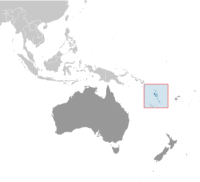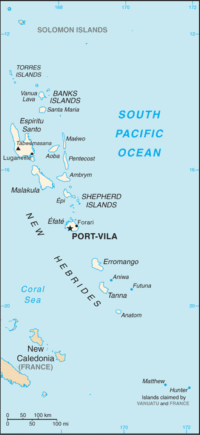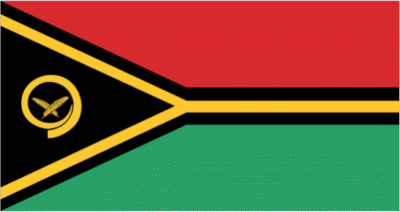| Republic of Vanuatu Ripablik blong Vanuatu
Origin of Name derived
from the words "vanua" (home or land) and
"tu" (stand) that occur in several of the
languages spoken on the islands and which provide the
meaning of "independence" or the sense of
"our land"
Total Area 4,706 sq mi
(12,189 sq km)
Highest Point Tabwemasana; 6,158 ft
(1,877 m)
Lowest Point sea level
Natural Resources manganese


Nationality Ni-Vanuatu
Population (July 2015) 272,264
Ethnic Groups Ni-Vanuatu
Religions Protestant
Languages Bislama, English, French (all
official), and over 100 local languages
Form of Government
parliamentary republic
Present Constitution Adopted July 30,
1980
Capital Port-Vila
Chief of State President Baldwin
Lonsdale (since September 22, 2014)
Head of Government Prime Minister
Charlot Salwai (since February 11, 2016)
Cabinet Council of Ministers appointed
by the Prime Minister
Legislature unicameral Parliament
Judiciary Supreme Court
Local Administration 6 provinces
Currency vatu (VUV)
Per Capita Income $2,500
Industries food and fish preezing, wood
processing, meat canning
Agricultural Products copra, coconuts,
cocoa, coffee, taro, yams, fruits, vegetables; beef; fish
Export Commodities copra, beef, cocoa,
timber, kava, coffee
Import Commodities machinery and
equipment, foodstuffs, fuels
Independence from France and
the United Kingdom Achieved July 30, 1980
National Holiday Independence Day; July
30
Flag centered in the triangle is
a boar's tusk encircling two crossed namele fern fronds,
all in yellow; red represents the blood of boars and men,
green the richness of the islands, and black the
ni-Vanuatu people; the yellow "Y" shape, which
reflects the pattern of the islands in the Pacific Ocean,
symbolizes the light of the Gospel spreading through the
islands; the boar's tusk is a symbol of prosperity
frequently worn as a pendant on the islands; the fern
fronds represent peace

SEE ALSO
Australia
Queen of Elizabeth II
Questions or comments about this
page?
|
 SKC Films Library
SKC Films Library

